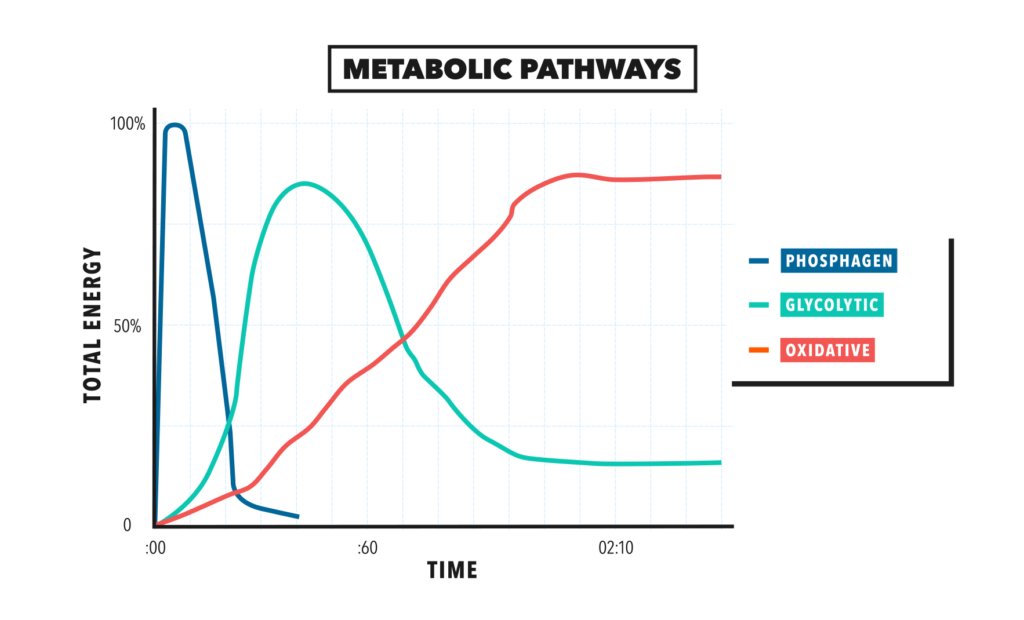It’s About Time…


Ever wonder why some WODs at CrossFit Rockland fly by in less than 5 minutes, while others keep you grinding for 20+? Those time domains aren’t random—they’re part of a deliberate system designed to build complete, capable athletes.
The Three Engines of Fitness
Your body has three major “metabolic engines” that power movement, each kicking in based on how long and how hard you’re working. CrossFit HQ outlines them in “What Is Fitness? Part 2 – Metabolic Pathways”:
1. Phosphagen (Short, ~0–10 seconds): This system fuels explosive efforts—think heavy singles or short sprints. It’s anaerobic and relies on stored ATP and phosphocreatine.
2. Glycolytic (Medium, ~30–90 seconds): This system powers high-intensity work over moderate durations, like a Fran-style burner. It also runs anaerobically and produces lactate.
3. Oxidative (Long, 2+ minutes): This aerobic system keeps you moving over long durations—think Murph, rowing, or steady-state work.
These systems aren’t on/off switches—they’re always active. But one typically dominates depending on the task at hand.
Why We Program Across All Time Domains
CrossFit isn’t about specializing in just one system—it’s about building broad, adaptable capacity. That’s why our programming rotates through short, medium, and long workouts.
Time Domain Duration Dominant System Example WOD
Short 10 seconds Phosphagen 1RM Clean, Sprint
Medium 30–90 seconds Glycolytic Grace, Fran
Long 2+ minutes Oxidative Murph, 20-min AMRAP
If you only trained in one time domain, you’d build strengths—but also leave critical gaps. That’s why the fittest athletes are those who embrace the sprint, the power lift and the long grind.
The Science Behind the Systems
Here’s where the real magic happens: CrossFit programming trains all three energy systems over time—not necessarily in the same workout, but across the week, month, and year. This ability to perform well in each domain, called metabolic flexibility, is one of the biggest reasons CrossFit works so well.
Think of it this way:
A 1RM or 3RM heavy deadlift (short, explosive effort) primarily taxes the Phosphagen pathway.
A 5K run (long, sustained effort) lives in the Oxidative domain.
A workout like “Fran” (fast, high-intensity effort lasting a few minutes) sits in the Glycolytic domain.
You can’t truly test all three pathways in a single workout, because they’re defined by time and intensity. For example, if a workout lasts 11–20 minutes, by definition, it will primarily tax the Oxidative system—even if it contains a mix of heavy lifts, runs, or gymnastics.
The magic in CrossFit is the blend over time:
Monday: a heavy lift (Phosphagen)
Tuesday: a longer endurance piece (Oxidative)
Wednesday: a fast, high-power workout (Glycolytic)
By cycling through these domains in a deliberate way, we build athletes who can sprint, grind, and endure—without specializing in just one. That’s what separates CrossFit from traditional training.
Final Takeaway
The next time you see a fast-and-furious sprint WOD, don’t think “We didn’t really workout for long enough today”. Or if there is a long chipper, don’t think “We don’t do enough lifting!”—instead think, “Which energy system am I training today?”
And if it’s a workout you typically avoid… that’s probably the system you need to work on most.
Keep showing up. Keep building your engines. And remember: your fitness isn’t about reinforcing what you’re already good at—it’s about how well you can adapt.